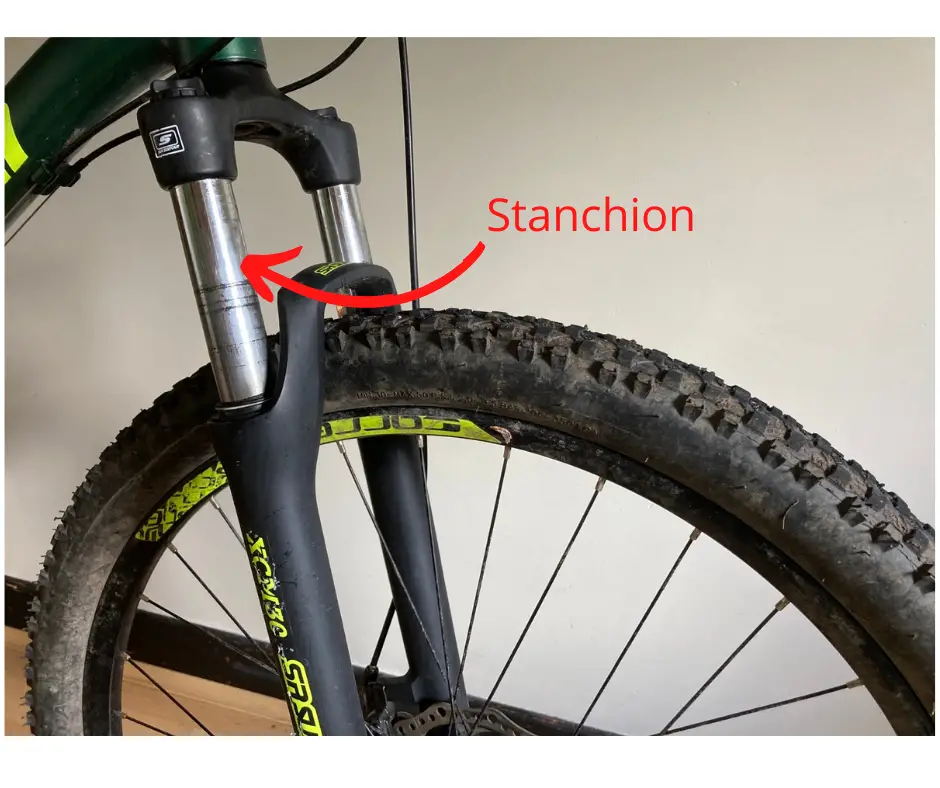Front suspension forks are up there with the most important components on a mountain bike. They have a significant impact on both comfort and performance.
Stanchion diameter is one of the main dimensions used to categorize MTB forks, along with travel. Understanding stanchion diameter and what effect it has on your bike is really important.
Here are 6 answers about MTB stanchion diameter:
Table of Contents
1. What is Stanchion Diameter?
Stanchion diameter is simply the width of the stanchion of a mountain bike fork, with stanchions themselves being the upper sections of the forks that slide into the lowers. They provide damping as the bike hits bumps, jumps, and drops.

They’re a fundamental part of the suspension fork, and ensuring you have the correct size is really important for the overall quality of your ride.
2. Why is Stanchion Diameter Important?
Stanchion diameter is important because selecting the right fork size for your riding style and body type has a drastic effect on your performance and comfort.
Selecting a stanchion diameter that is too big for your riding style will mean you’re lugging additional weight around unnecessarily.
Choosing stanchions too small for your riding style or body type means your suspension won’t be rigid enough, making the ride uncomfortable, reducing the life of your suspension, and potentially causing an accident in the worst case should your forks buckle.
3. How is Stanchion Diameter Measured?
To measure the diameter of a bike’s stanchions, take a piece of string, a zip tie, or something else you can wrap around the stanchion.
Using the string (or whatever else you have), wrap it around the stanchion and either mark it with a pen or pinch it between your fingers just at the point where the string meets around the stanchion.
Now take this length of string and measure it. The length of string you’ve measured is the circumference of the stanchion, so to get the diameter you need to divide that number by 3.142 using a calculator or phone (or your brain if you’re a math wiz).
Dividing the circumference by 3.142 (this is just Pi) gives the diameter of the stanchion.
Alternatively, if you’re trying to figure out the diameter of your stanchions and you know the make and model of your forks, you can easily find the diameter by Googling them.
The manufacturer’s website or a supplier’s website will have the info you need.
4. Are Bigger Stanchions Better?
You may be wondering which stanchion diameter is best, and if bigger/wider stanchions are better.
There’s a trade-off when it comes to stanchion diameter. Modern forks typically come with 32, 34, 36, 38, or 40mm stanchions.
Bigger or wider stanchions are not necessarily better. The best stanchion diameter is based on the type of riding you use your bike for and how heavy you are.
The wider the stanchion, the more rigid they are. A wider fork will flex less when hitting obstacles and jumps, but will also weigh more.
32mm stanchions are generally used for cross-country bikes where there are usually no jumps, and weight saving is a high priority.
The other extreme is downhill bikes which commonly have 40mm stanchions. The extra weight of 40mm stanchions is worth it for the extra strength and rigidity when riding downhill.
Trail bikes and enduro bikes fall in the middle, with trail bikes often having 34mm to 36mm stanchions, with enduro bikes usually opting for 36mm – 38mm stanchions.
The other factor to consider is how heavy you are. For example, whilst many cross-country bikes have 32mm stanchions, you may be better off with 34mm if you’re on the heavier side.
Whilst your ideal stanchion diameter may be different from the next person, there are a number of things to look out for to identify a good quality fork regardless of thickness that we’ve summarised here.
5. Are 32mm Stanchions Enough?
This follows on from the previous question about stanchion diameter.
32mm stanchions will be fine if you’re using your MTB for smooth trails or cross-country type riding where you don’t encounter jumps or drop-offs, and the trails you ride are free from large obstacles.
If you ride a variety of trails and some of them have features like jumps and rock gardens, you may be better off with a larger fork diameter.
Additionally, if you’re quite a heavy person, you’ll likely benefit from the extra rigidity of moving up a size and going for 34mm stanchions even if you only ride tame trails.
If you like going to the bike park and tackling jumps or anything above blue grade trails, you’d be much better off going for thicker stanchions.
6. Are Wider Stanchions More Expensive?
A fork with a bigger stanchion diameter naturally has more material in the fork which means wider stanchions can mean slightly higher costs.
That said if you’re looking at a 34mm vs a 36mm fork of similar specifications from the same supplier, the price shouldn’t differ too much. Other factors aside from stanchion diameter have a much more significant effect on fork price.
As with most things, you get what you pay for. We dedicated an entire article to determine whether or not expensive forks are worth it here.
And whilst we’re on the topic of expensive forks it’s worth mentioning Fox – the industry leader in mountain bike forks charges some hefty prices for their top models. If you’re interested in why Fox forks are so expensive, check out the article we wrote here.
